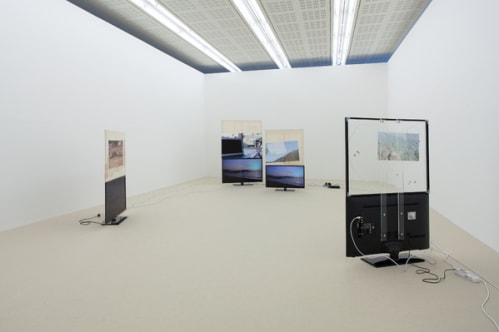Philipp Timischl “Philipp, I have the feeling I'm incredibly good looking but have nothing to say", installation view, 21er Haus, Austria, 2013 “Philipp, I have the feeling I’m incredibly good looking, but have nothing to say,” the exhibition confesses. It presents itself as being superficially beautiful and incidental. At first glance the viewer is faced with a very impersonal scene. Flat screens are arranged in the gallery space, all showing the same video at the same time. The display in this exhibition appears as generic as a shop of electrical gadgets with their row upon row of simultaneous screens, a subject Philipp Timischl has already tackled in earlier works. At the exhibition No inter¬est, no aim, beyond nothing, shown in Frankfurt in 2010, he explored notions of the universally valid and interchangeable, also through the medium of video. The work comprised establishing shots: city panoramas, slow-motion scenes of nature or helicopters flying over skyscrapers that are usually used to provide spatial context in a cinematic narrative. As such shots are the most expensive and time-consuming to produce, stock footage is used in many cases. Timischl isolated shots from the reality show The Real L Word until all that remained was a storyless, interchangeable, hypnotic collage of clips. The video on the screens in this exhibition now tries to conjure up a similar atmosphere using comparable methods, such as shaky shots of landscapes, blurred details or exaggerated jump cuts. Here, however, it is anything but anonymous. In fifteen minutes and using rapid cuts it tells the story of a vacation. A plane takes off, flies through the clouds and lands. Timischl goes by bus and meets his injured holiday romance again in front of a hospital. A bus and train journey later: View from a terrace. Legs are dangling in the air. Timischl drives to the beach with his friends. They swim and dive. Over dinner they talk about the video and filming. Later the camera is trained on the artist; he feels awkward and says nothing. A friend reads about the history of the village church. In the car, traffic jam and again the beach. These are followed by shots of the harbor and dinner. A conversation on the beach, a nocturnal walk, a town fair. This highly atmospheric video is shown simultaneously on the flat screens while stills displaying individual frames from the video have been attached to these using wall mounts. When you watch the video, the sculptures’ images double for the duration of one frame, each time highlighting a specific aspect in the narrative. This deliberately draws the focus of the viewer deeper into what underlies these superficial holiday impressions. One of these aspects is the relationship between work and life. In the daily professional life of an artist, a role model for contemporary concepts of work and life, these boundaries are not only blurred but seem utterly intermeshed and interchangeable. Even a vacation signifies both rest and activity to the point where in this case it is subsequently transformed into art. Presenting this in an exhibition space also blurs the boundaries between private and public. Nowadays we often set out to document and present personal moments with an assumed, sometimes anonymous audience in mind. Timischl exalts these moments and compiles them into an allegedly authentic mini-documentary. This privacy creates closeness, yet this is ruptured by the protagonists’ awareness of the power of these freely circulating images and the consequent representative nature of their actions. Sometimes this creates the impression of a scripted reality, a mock documentary that follows a script. It seems as if something extraordinary, some anomaly could appear at any moment; as if the everyday on vacation is in fact a fiction. In spite of this, the images are as interchangeable as the mass-produced screens showing them. They are like an advertisement attempting to convey intimacy and credibility with these emotional, shaky shots.

